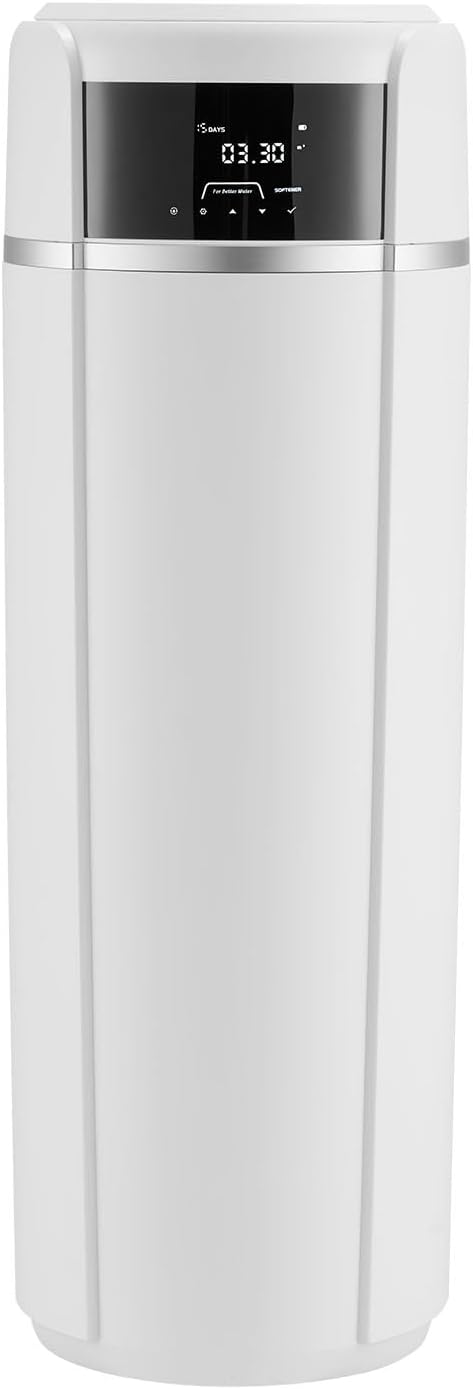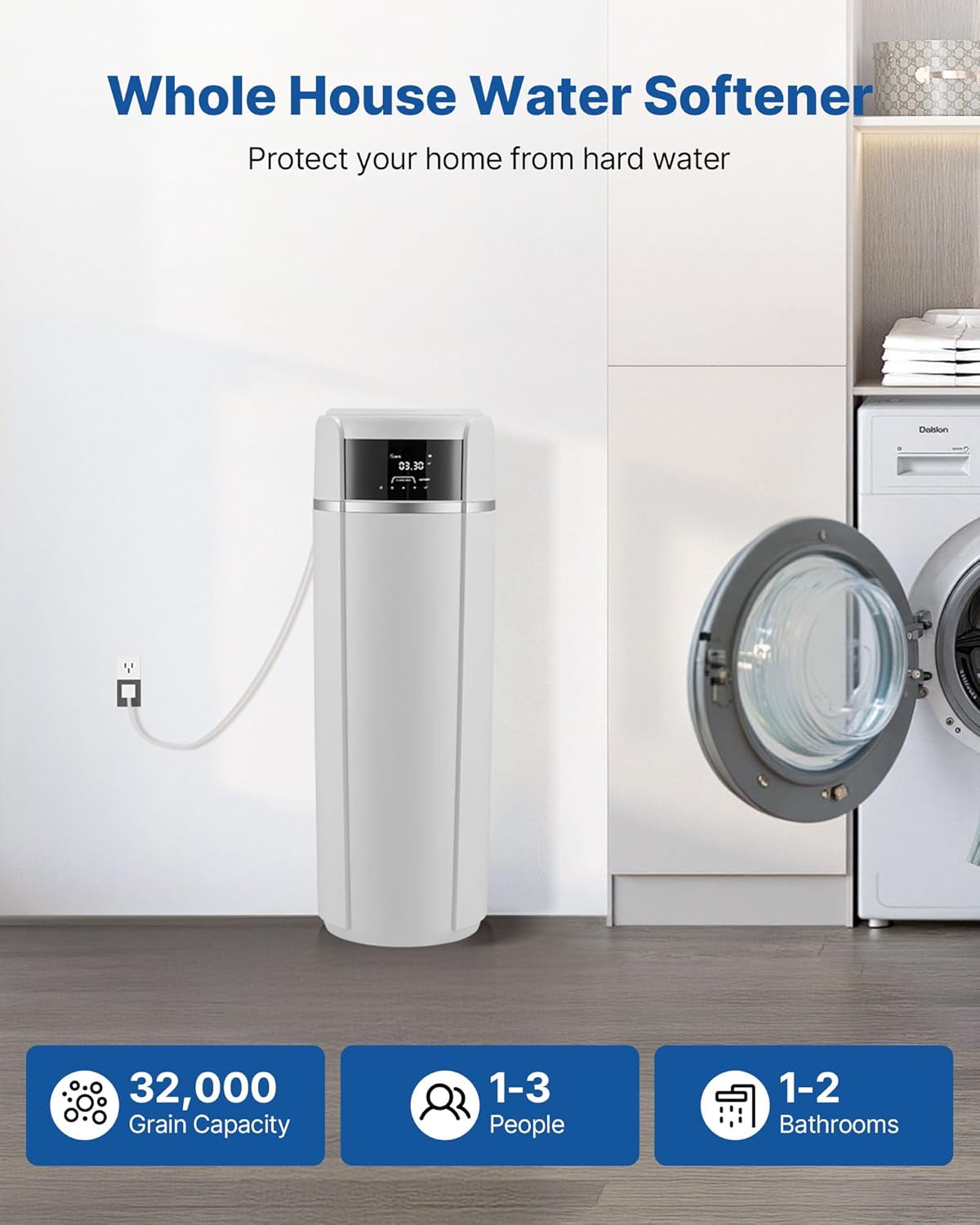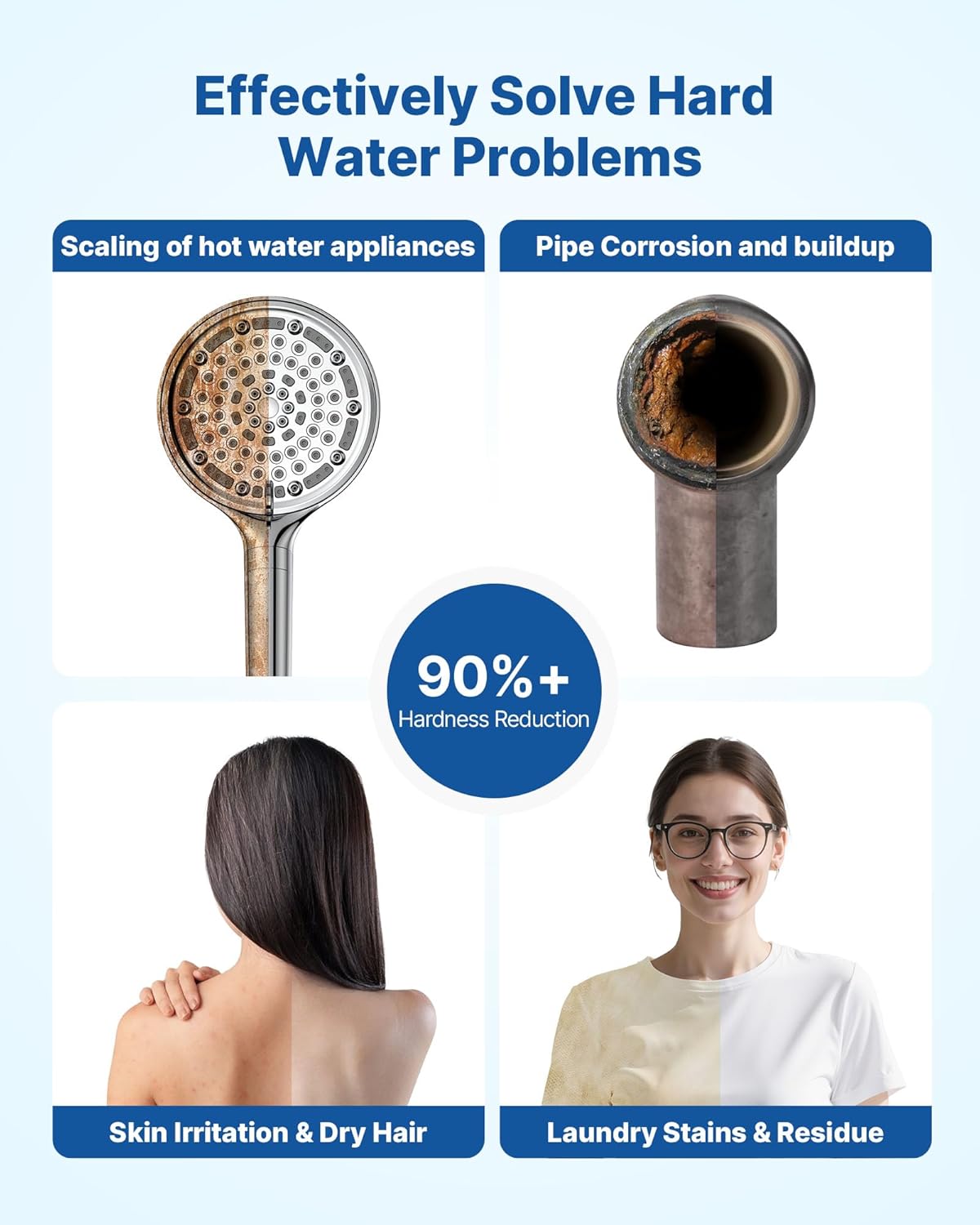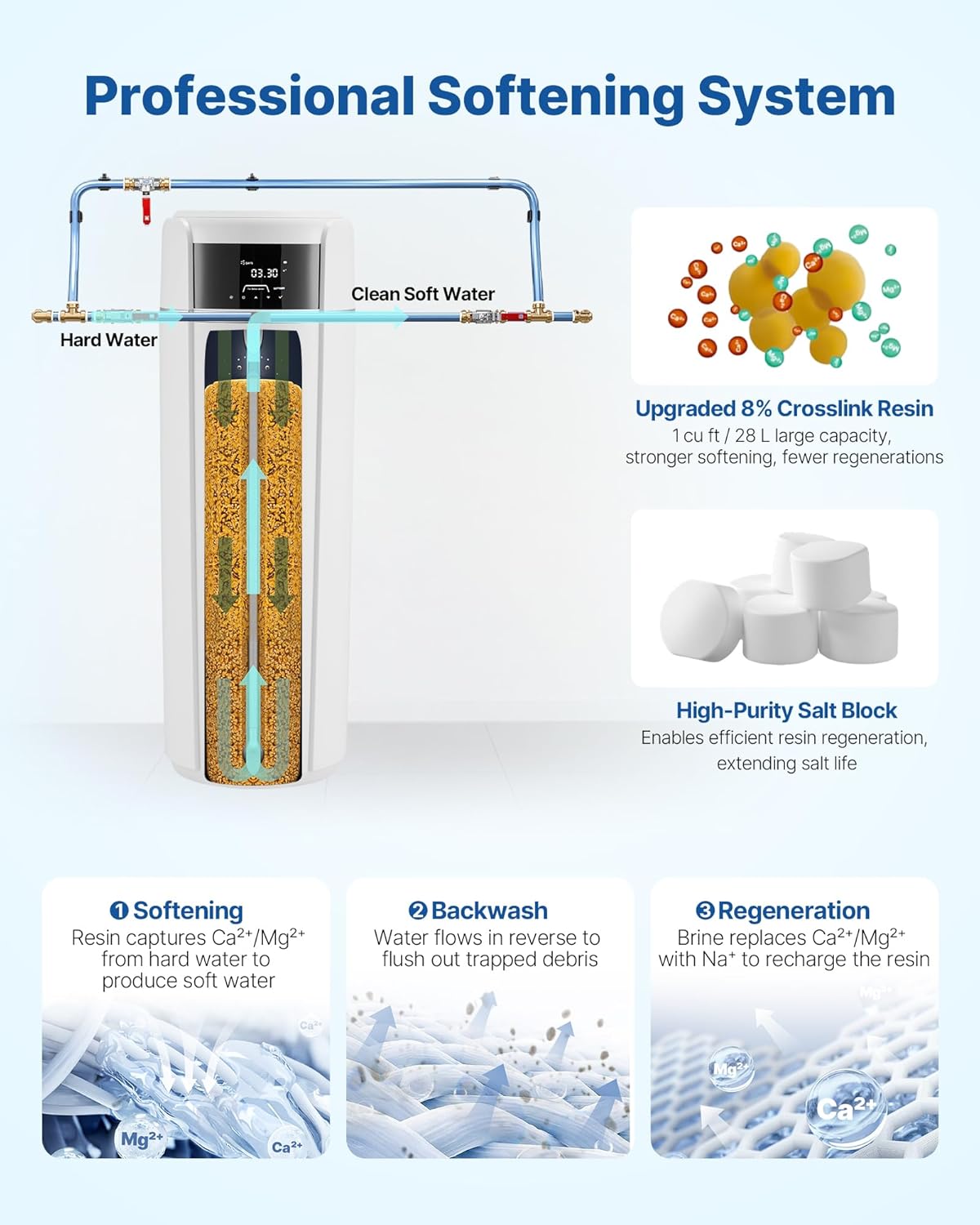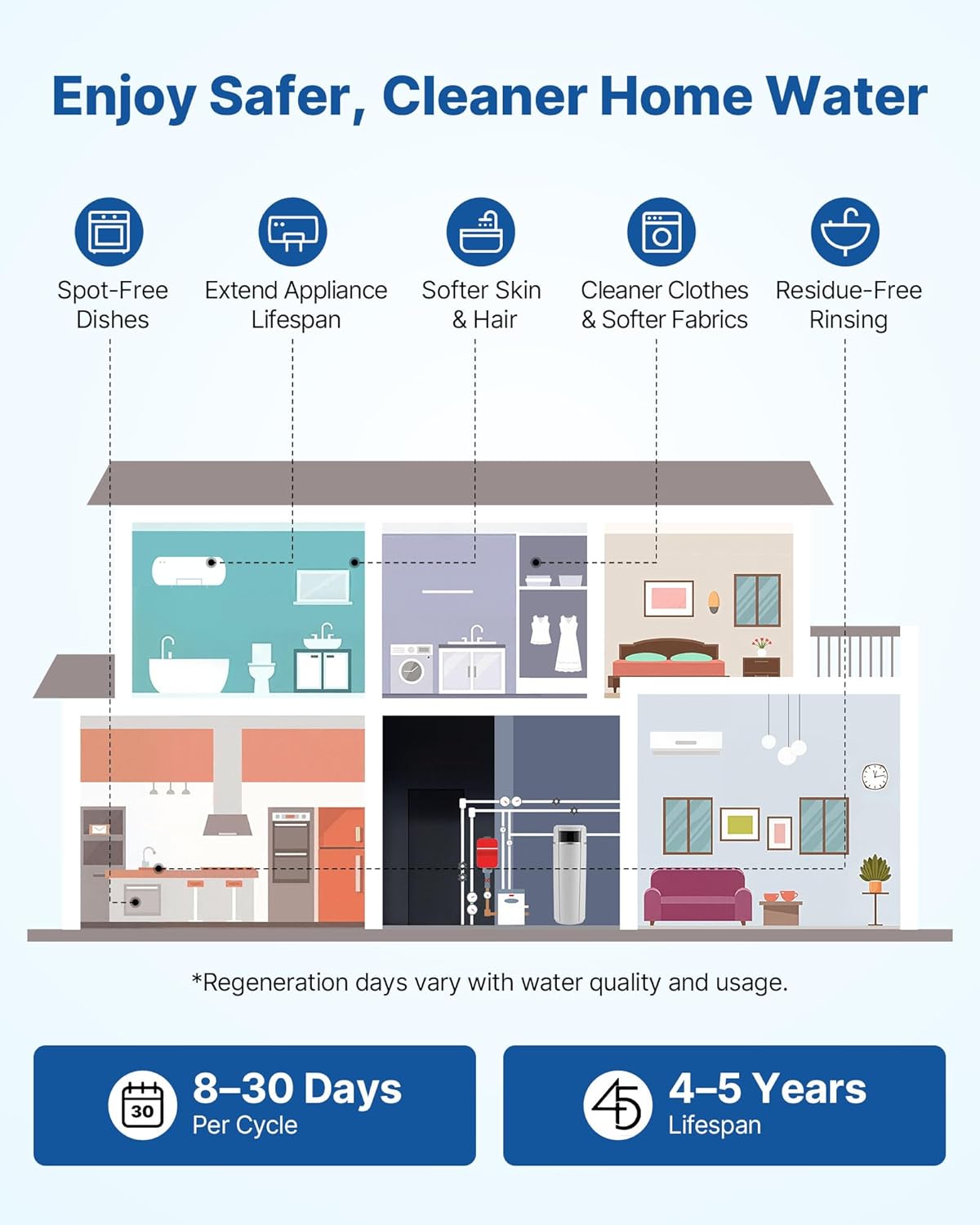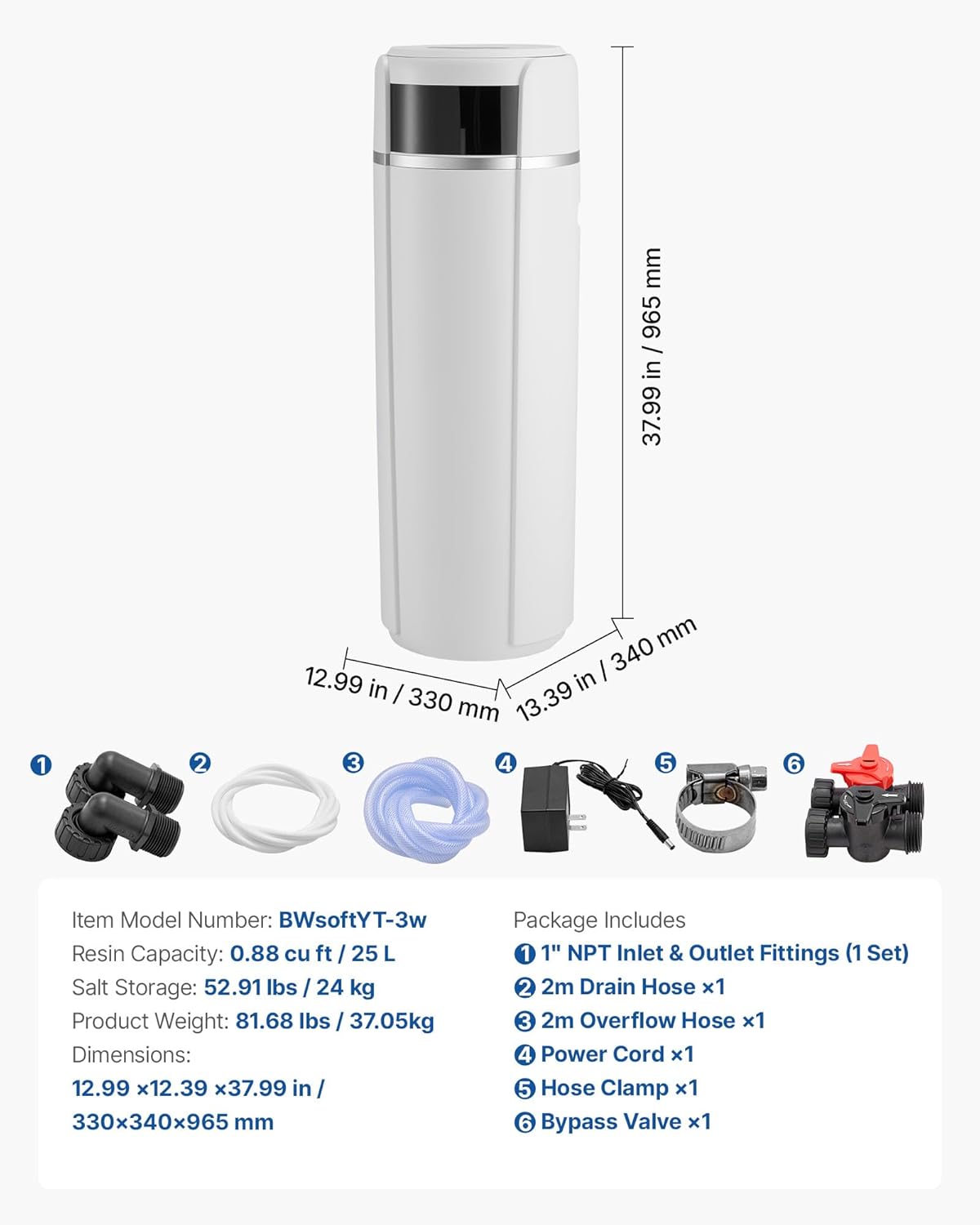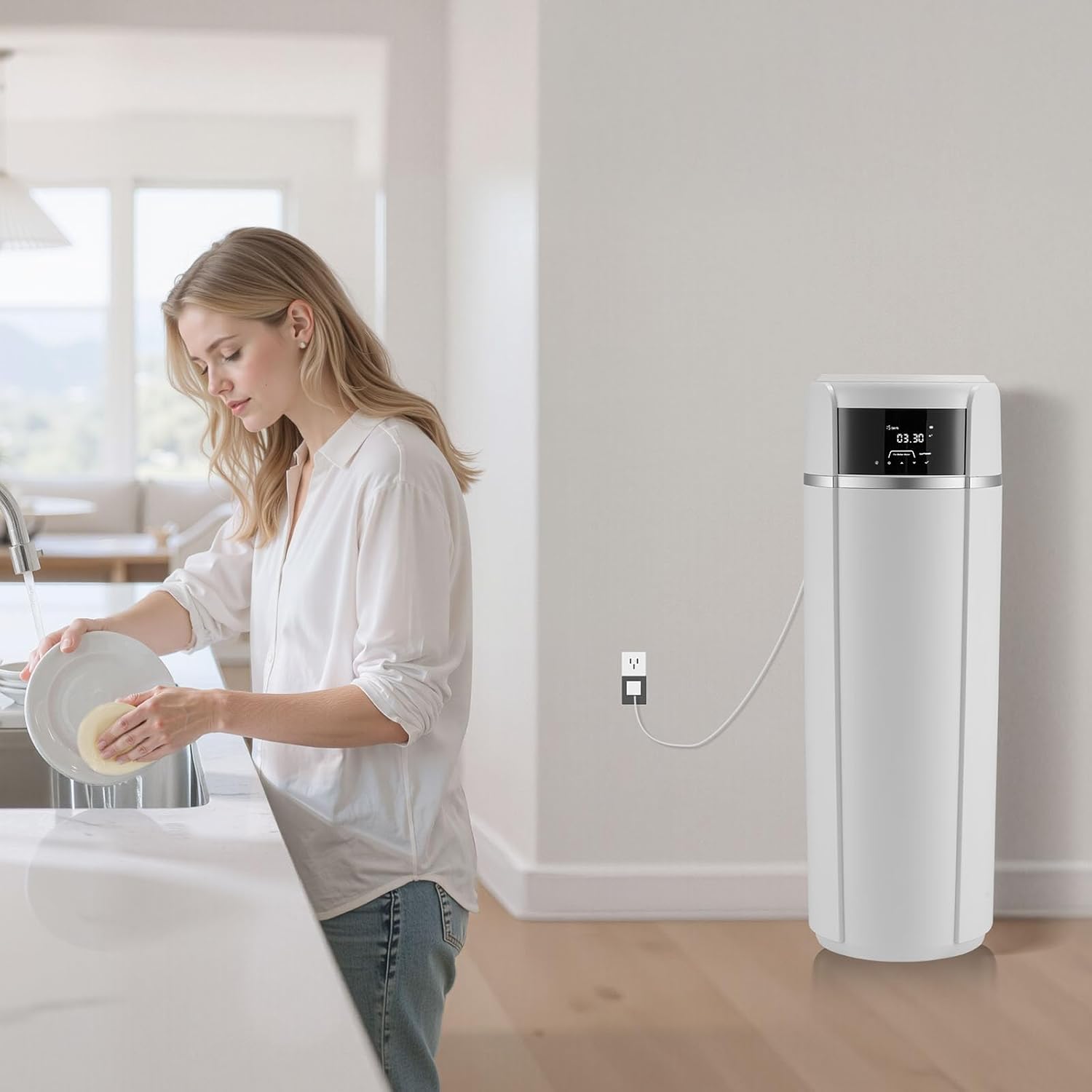
VEVOR Water Softener, 32,000 Grains Review water softener – Oemiu
Is the VEVOR 32,000 Grain Water Softener Right for You? A Deep Dive
Imagine stepping out of the shower and feeling your skin refreshed, not tight and itchy. Picture appliances lasting longer, free from the damaging effects of limescale buildup. This is the promise of softened water, and the VEVOR 32,000 Grain Water Softener aims to deliver that promise at a competitive price point. But does it live up to the hype? This comprehensive review will explore every facet of this popular home water softener, helping you decide if it’s the right solution for your needs. We’ll cover its features, performance, installation, and potential drawbacks, offering a balanced perspective to guide your purchasing decision.
Understanding Hard Water and the Need for Softening
Hard water is a common issue, affecting households across the globe. It’s caused by high concentrations of minerals, primarily calcium and magnesium, dissolved in the water. These minerals, while not necessarily harmful to drink, can wreak havoc on your plumbing, appliances, and even your skin and hair. The telltale signs of hard water include:
* Limescale buildup on faucets, showerheads, and in appliances like kettles and coffee makers. This unsightly white or yellowish crust reduces water flow and diminishes appliance efficiency.
* Dry, itchy skin and dull, lifeless hair after showering. Hard water interferes with the lathering of soaps and shampoos, leaving a residue that can irritate the skin and hair follicles.
* Increased soap and detergent consumption. Hard water prevents soaps and detergents from working effectively, requiring you to use more to achieve the same level of cleaning.
* Reduced lifespan of appliances like water heaters, washing machines, and dishwashers. Limescale buildup can clog heating elements, reduce heat transfer efficiency, and ultimately lead to premature failure.
Water softening systems address these problems by removing the calcium and magnesium ions that cause hard water. The most common type of water softener, like the VEVOR 32,000 grain model, uses a process called ion exchange. This involves passing the hard water through a resin bed that’s coated with sodium or potassium ions. As the hard water flows through the resin, the calcium and magnesium ions are exchanged for sodium or potassium ions, resulting in softened water. When the resin bed becomes saturated with calcium and magnesium, it needs to be regenerated, typically using a brine solution (saltwater). This regeneration process flushes the calcium and magnesium from the resin bed and replenishes it with sodium or potassium ions, preparing it for another cycle of water softening.
VEVOR 32,000 Grain Water Softener: Features and Specifications
The VEVOR 32,000 Grain Water Softener is designed for households with moderate water hardness and usage. It boasts a compact design and a user-friendly interface, making it an appealing option for those new to water softening systems. Let’s delve into its key features and specifications:
* **Grain Capacity:** 32,000 grains. This refers to the amount of hardness the softener can remove before needing regeneration. A higher grain capacity generally means longer intervals between regenerations, saving you salt and water.
* **Flow Rate:** VEVOR claims a specific flow rate, and it is important to verify this matches your household needs. Insufficient flow rate can lead to a noticeable drop in water pressure when multiple fixtures are in use simultaneously.
* **Regeneration Type:** Typically metered or time-based. Metered regeneration is more efficient, as it regenerates only when necessary based on actual water usage. Time-based regeneration regenerates on a pre-set schedule, regardless of water consumption, which can lead to wasted salt and water. Knowing what is offered on the VEVOR model you are assessing is critical.
* **Digital Control Panel:** The digital display simplifies programming and monitoring the system’s performance. It often includes features like regeneration scheduling, salt level monitoring, and error code display.
* **Salt Storage Capacity:** Refers to the amount of salt the brine tank can hold. A larger salt storage capacity means fewer trips to refill the tank.
* **Connections:** Typically uses standard plumbing connections for easy installation.
Here’s a table summarizing the key specifications (ensure to check the VEVOR website or product manual for the most accurate and up-to-date information):
| Feature | Specification |
|---|---|
| Grain Capacity | 32,000 Grains |
| Flow Rate | (Verify on VEVOR website) |
| Regeneration Type | (Verify on VEVOR website) |
| Digital Control Panel | Yes |
| Salt Storage Capacity | (Verify on VEVOR website) |
| Connections | (Verify on VEVOR website) |
Beyond the specifications, consider the overall design and build quality. Is the unit compact enough to fit in your desired location? Does it appear durable and well-constructed? These factors contribute to the long-term reliability and satisfaction with your purchase.
Installation and Setup: A DIY Project or a Professional Job?
One of the primary considerations when purchasing a water softener is the installation process. The VEVOR 32,000 Grain Water Softener is generally marketed as a DIY-friendly system, but the level of ease depends on your plumbing skills and experience. The installation typically involves the following steps:
1. **Shutting off the main water supply:** This is crucial to prevent flooding during the installation process.
2. **Cutting into the main water line:** This requires careful planning and precise cuts to avoid damaging the pipes.
3. **Connecting the softener to the water line:** This usually involves using fittings like couplings, elbows, and nipples to connect the softener’s inlet and outlet ports to the main water line.
4. **Connecting the drain line:** The drain line is used to discharge the wastewater during regeneration. It needs to be properly connected to a drain to prevent backflow and contamination.
5. **Connecting the brine line:** The brine line connects the brine tank to the softener. It’s essential to ensure a secure and leak-proof connection.
6. **Programming the control panel:** This involves setting the water hardness level, regeneration schedule, and other parameters.
7. **Adding salt to the brine tank:** Use the appropriate type of salt recommended by the manufacturer.
8. **Testing the system:** After installation, thoroughly test the system for leaks and ensure it’s softening the water effectively.
While the installation process may seem straightforward, it can be challenging for those with limited plumbing experience. Incorrect connections can lead to leaks, water damage, and inefficient operation. If you’re unsure about any aspect of the installation, it’s best to hire a qualified plumber. A professional plumber can ensure the system is installed correctly, minimizing the risk of problems down the road. Furthermore, some local codes may require professional installation for water softeners. Check your local regulations before attempting a DIY installation.
Consider also the location of the softener. It needs to be placed near a water supply line, a drain, and an electrical outlet (if applicable for the control panel). The location should also be protected from freezing temperatures.
Performance and Efficiency: Does the VEVOR Deliver?
The ultimate measure of a water softener’s worth is its performance and efficiency. Does the VEVOR 32,000 Grain Water Softener effectively soften water, and does it do so in an efficient manner?
* **Softening Effectiveness:** This is the primary function of a water softener. The VEVOR 32,000 grain system should effectively remove calcium and magnesium from the water, reducing hardness to acceptable levels. You can test the water hardness using a test kit or by observing the signs of soft water, such as improved lathering of soaps and shampoos and reduced limescale buildup.
* **Regeneration Efficiency:** The frequency and duration of regeneration cycles impact the overall efficiency of the system. Metered regeneration is generally more efficient than time-based regeneration, as it regenerates only when necessary based on actual water usage. Look for features like adjustable regeneration settings and salt level monitoring to optimize efficiency.
* **Water Consumption:** Water softeners use water during the regeneration process. The amount of water used per regeneration cycle can vary depending on the model and settings. Look for models that minimize water consumption to conserve water and reduce wastewater discharge.
* **Salt Consumption:** Salt is required for the regeneration process. The amount of salt used per regeneration cycle can vary depending on the model and settings. Look for models that minimize salt consumption to save money on salt purchases.
To assess the VEVOR’s performance, consider real-world user reviews and testimonials. Look for feedback on the softening effectiveness, regeneration frequency, water consumption, and salt consumption. Keep in mind that performance can vary depending on water hardness levels and water usage patterns. If you have particularly hard water or high water usage, you may need a larger capacity softener. Some long-tail variations such as a whole house water softening system may be a better consideration. You may also consider a salt free water softener if that meets your needs.
Potential Drawbacks and Considerations
While the VEVOR 32,000 Grain Water Softener offers a compelling value proposition, it’s essential to be aware of its potential drawbacks and considerations:
* **Build Quality:** As a budget-friendly option, the build quality may not be as robust as higher-end models. Some users have reported issues with the durability of the components and the longevity of the system.
* **Customer Support:** Customer support can be a crucial factor, especially if you encounter problems during installation or operation. Research the availability and responsiveness of VEVOR’s customer support before making a purchase.
* **Warranty:** Carefully review the warranty terms and conditions to understand the coverage and limitations. A longer warranty period provides added peace of mind.
* **Flow Rate Limitations:** Cheaper water softeners might have a lower flow rate capacity. If multiple taps are used simultaneously, this may create a noticeable water pressure drop.
* **Regeneration Noise:** The regeneration process can generate some noise. If the softener is located near living areas, the noise may be disruptive.
* **Salt Bridge Formation:** Salt can sometimes form a “bridge” in the brine tank, preventing the salt from dissolving properly. This can lead to inefficient regeneration. Regularly check the brine tank and break up any salt bridges that may form.
Before making a purchase, weigh these potential drawbacks against the benefits and consider your specific needs and priorities.
Alternatives to the VEVOR 32,000 Grain Water Softener
The VEVOR 32,000 Grain Water Softener is not the only option available. Several other water softeners on the market offer similar features and performance. Consider these alternatives:
| Brand | Model | Grain Capacity | Key Features | Approximate Price |
|---|---|---|---|---|
| (Brand A) | (Model A) | (Capacity) | (List features) | (Price) |
| (Brand B) | (Model B) | (Capacity) | (List features) | (Price) |
| (Brand C) | (Model C) | (Capacity) | (List features) | (Price) |
When comparing water softeners, consider the following factors:
* **Grain Capacity:** Choose a grain capacity that’s appropriate for your water hardness and water usage.
* **Flow Rate:** Ensure the flow rate is sufficient to meet your household’s demands.
* **Regeneration Type:** Metered regeneration is generally more efficient than time-based regeneration.
* **Features:** Look for features like digital control panels, salt level monitoring, and adjustable regeneration settings.
* **Build Quality:** Choose a softener with a durable construction and reliable components.
* **Warranty:** Look for a comprehensive warranty that provides adequate coverage.
* **Price:** Compare prices from different retailers to find the best deal.
Some other softening systems may offer salt-free water softening or electronic water softeners, which are different technologies that do not use salt. Another possibility may be whole house water filters, which address different water issues but may improve the overall water quality of the home. Understanding your specific needs and priorities is crucial when choosing a water softener.
FAQ: Addressing Your Questions About the VEVOR Water Softener
What size water softener do I need for my home?
The size of water softener you need depends primarily on two factors: the hardness of your water and your household’s water consumption. Water hardness is measured in grains per gallon (GPG). You can test your water hardness using a home test kit or by contacting your local water utility. Water consumption is typically measured in gallons per day (GPD). Estimate your household’s water usage by considering the number of people in your household, the number of bathrooms, and your typical water-using activities (e.g., showering, laundry, dishwashing). Once you know your water hardness and water consumption, you can use a water softener sizing chart to determine the appropriate grain capacity. A general guideline is that a 32,000-grain water softener is suitable for a household of 1-4 people with moderate water hardness (7-10 GPG). However, if you have very hard water or high water consumption, you may need a larger capacity softener. It is always better to overestimate than underestimate your needs.
How often does the VEVOR water softener need to regenerate?
The regeneration frequency of your VEVOR water softener depends on your water hardness, water usage, and the regeneration settings. With metered regeneration, the softener regenerates only when the resin bed becomes saturated with hardness minerals. This minimizes salt and water consumption compared to time-based regeneration, which regenerates on a pre-set schedule, regardless of water usage. The higher the water hardness and water consumption, the more frequently the softener will need to regenerate. You can adjust the regeneration settings on the control panel to optimize the regeneration frequency. Some softeners also have a salt level monitoring feature that alerts you when the salt level is low, helping you maintain optimal performance. As a general rule, a 32,000-grain softener serving a family of four with moderate water hardness might regenerate every few days to once a week.
What type of salt should I use in my VEVOR water softener?
The most common types of salt used in water softeners are rock salt, solar salt, and evaporated salt. Rock salt is the least expensive option, but it contains impurities that can accumulate in the brine tank and reduce the softener’s efficiency. Solar salt is made by evaporating seawater and is generally purer than rock salt. Evaporated salt is the purest type of salt, produced by evaporating water from brine wells. VEVOR’s manual will specify what to use, however generally, evaporated salt is the most recommended option due to its high purity, minimal impurities, and efficient dissolving properties. Block salt is sometimes used but can cause bridging issues. It’s important to choose a salt that’s specifically designed for water softeners and to avoid using table salt or other types of salt that may contain additives that can damage the system. Always follow the manufacturer’s recommendations for salt type and usage.
Is the VEVOR water softener difficult to install?
The difficulty of installing the VEVOR water softener depends on your plumbing skills and experience. The installation typically involves cutting into the main water line, connecting the softener to the water line, connecting the drain line, connecting the brine line, and programming the control panel. If you’re comfortable with basic plumbing tasks and have the necessary tools, you may be able to install the softener yourself. However, if you’re unsure about any aspect of the installation, it’s best to hire a qualified plumber. A professional plumber can ensure the system is installed correctly, minimizing the risk of leaks and other problems. Moreover, improper installation can void the warranty. Check local plumbing codes, as some areas require professional installation.
How long does the VEVOR water softener last?
The lifespan of the VEVOR water softener depends on several factors, including the quality of the water, the frequency of regeneration, and the maintenance practices. With proper care and maintenance, a water softener can last for 10-15 years or even longer. Regular maintenance tasks include checking the salt level, cleaning the brine tank, and inspecting the components for wear and tear. Over time, the resin bed may become less effective at removing hardness minerals, requiring replacement. Some signs that the resin bed needs replacement include a decrease in water softening effectiveness, an increase in regeneration frequency, and a change in the taste or odor of the water. However, note that as a budget-friendly option, the lifespan of the VEVOR may be somewhat less than some premium models.
What are the benefits of using a water softener?
There are numerous benefits to using a water softener, including:
* **Improved Skin and Hair:** Soft water is gentler on the skin and hair, leaving them feeling softer and smoother.
* **Reduced Limescale Buildup:** Soft water prevents limescale buildup in plumbing, appliances, and fixtures, extending their lifespan and improving their efficiency.
* **Increased Soap and Detergent Effectiveness:** Soft water allows soaps and detergents to lather more effectively, reducing the amount needed for cleaning.
* **Brighter and Cleaner Laundry:** Soft water helps clothes come out brighter and cleaner, without mineral deposits that can dull colors.
* **Energy Savings:** By preventing limescale buildup in water heaters and other appliances, soft water can improve energy efficiency and reduce energy costs.
* **Cost Savings:** Over the long run, the above factors contribute to overall cost savings by reducing repairs and replacement costs, improving energy efficiency, and decreasing soap and detergent use.
Is softened water safe to drink?
Softened water is generally safe to drink for most people. The ion exchange process replaces calcium and magnesium ions with sodium or potassium ions. The amount of sodium added to the water is typically small and doesn’t pose a health risk for most individuals. However, people on low-sodium diets or with certain medical conditions (e.g., high blood pressure, kidney disease) may need to consult with their doctor before drinking softened water. An alternative is to use potassium chloride as the regenerating salt. Also, a separate, unsoftened tap for drinking water can be installed in the kitchen.
